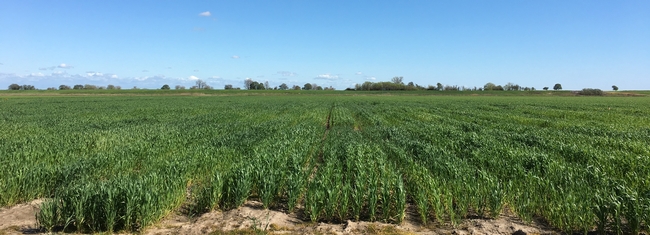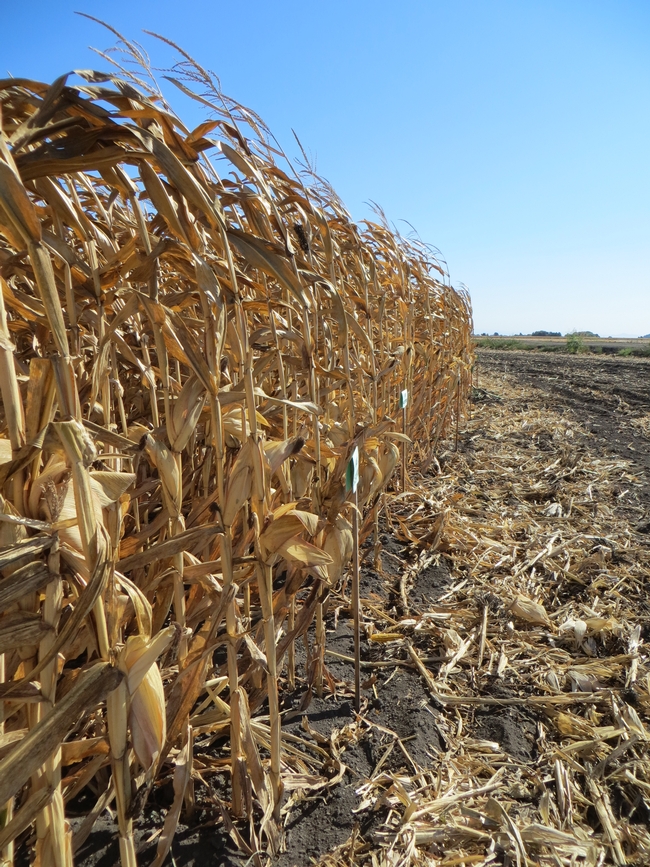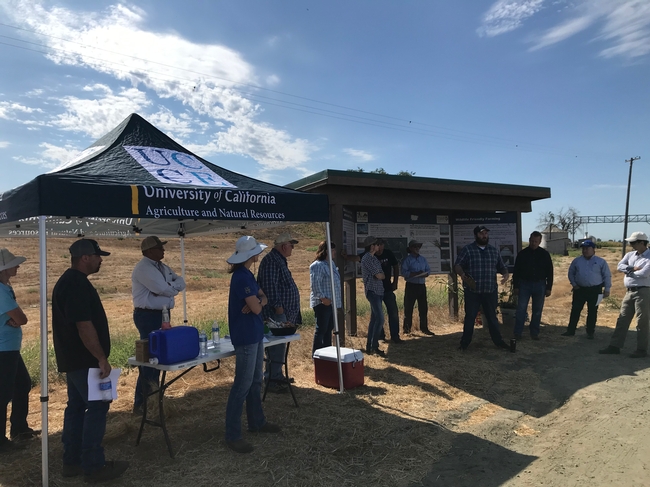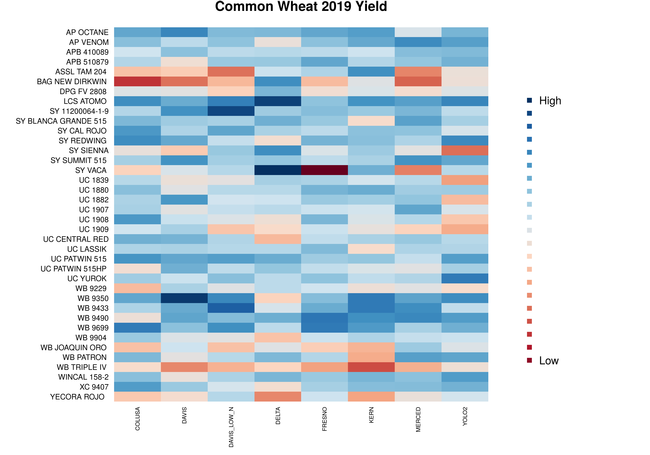- Author: Michelle Leinfelder-Miles
The annual UC Davis Alfalfa and Small Grains Field Day will take place on Thursday, May 11, 2023 at the Department of Plant Sciences Field Facility (2400 Hutchison Drive, Davis, CA 95616). Registration opens at 7:30am, and the wagons leave for the field at 8am. The event is free and open to the public, but registration is requested. Lunch is sponsored by the CA Crop Improvement Association, and continuing education credits will be available. Directions are as follows:
The field day is located on Hutchison Drive, just west of Davis. Take the Hwy. 113 exit north from I-80, or Hwy. 113 south from Woodland. Exit west on Hutchison Drive. Take a right at the first roundabout, a left at the second roundabout, and the field headquarters is about ¼ mile down in a clump of trees and buildings on the left.
The agenda is as follows:
8:10 Alfalfa Breeding Efforts at UC Davis - Charlie Brummer
8:20 Choosing Varieties for Pest Resistance - Dan Putnam
8:30 IPM and Importance of Management of Insect Resistance in Alfalfa - Ian Grettenberger
8:40 Test your Weed IQ - Identification of Weeds - Brad Hanson
8:55 Use of Compost to Improve Soils in Alfalfa - Michelle Leinfelder-Miles
9:05 Sorghum Projects for Forage and Biofuels - Jackie Atim
9:15 Improving Agronomic and Grain Quality Traits in Sorghum under Well-watered and Drought Conditions - Christine Diepenbrock
9:35 Flood or Drought? Alfalfa Strategies for Coping with California's Future - Dan Putnam
9:45 Teff as an Alternative Summer Forage Crop - Dan Putnam
9:50 Overhead Irrigation Technologies for Improved Efficiency - Isaya Kisekka
10:05 Updates from UC Davis Small Grains Breeding Program - Jorge Dubcovsky
10:20 Effects of Genotype and Environment on Productivity and Quality in California Malting Barley - Maany Ramanan
10:30 California Grain Foundation and Research on Food Use of Triticale - George Fohner
10:40 Small Grain Research Update from Tulelake - Rob Wilson
10:55 Evaluating Digestate and Hydrolysate as Alternative N Sources in Small Grains - Valentina Roel
11:05 Biosolids as a N Fertilizer Source in California Small Grains - Konrad Mathesius
11:15 Helping Farms in the Central Coast get N Scavenging Credits for Cereal Cover Crops - Eric Brennan
11:25 DIY In-field Plant Tissue Tests to Determine N Sufficiency in Wheat - Karla Estrada
11:30 Updates on Small Grain Research and Production in the Central Valley - Mark Lundy
11:45 Tour Small Grain Variety Trials
12:10 Lunch
1:20 Small Grain Breeding Field Day

- Author: Michelle Leinfelder-Miles
UC Cooperative Extension will provide a training on small grains nitrogen management and a webtool that can help inform recommendations. The meeting will take place on Wednesday, December 14th, from 10:00am to 12:00pm, at the SJC Cabral Agricultural Center (2101 E. Earhart Ave., Stockton, 95206). The training is primarily directed toward crop consultants, but we also welcome growers and industry members to attend. Attendance is free, but we request pre-registration using this survey because we will offer lunch. Continuing education credits will be offered (CCA and N management applications pending). The agenda is pasted below, and a downloadable version is attached. Thank you for your interest in UC Cooperative Extension programming, and we hope to see you at the training!
Agenda:
9:40 a.m. Registration, light refreshments
10:00 a.m. Welcome and Introduction
10:05 a.m. Principles of N fertilizer use in California small grains
10:15 a.m. Measuring field data pre-plant and in-season: N-rich reference zones, Soil sampling for nitrate
10:30 a.m. Soil nitrate quick test demonstration and data interpretation
10:45 a.m. Webtool example and case studies
11:00 a.m. Webtool walk through
11:40 a.m. Crop Consultant/CCA forum, survey, feedback, and discussion
12:00 p.m. Adjourn and Lunch, Please RSVP using this link
Small Grains Nitrogen Management Training Agenda

- Author: Michelle Leinfelder-Miles
- Author: Mark Lundy

The Delta trial was planted on November 15, 2018 and consisted of 38 common wheat varieties and 10 triticale varieties in three replicate blocks. Following a tomato rotation, the trial was planted on 60-inch raised beds, and no nitrogen fertilizer was applied to the field ahead of planting small grains. Neither was irrigation applied during the season, as rainfall amounted to approximately 22.5 inches over the season (Staten Island CIMIS station).
Trial results can be viewed interactively from the Agronomy Research and Information Center Small Grains page. Regional summaries are based on 3 years of trial data across multiple locations. The Delta location is grouped with the Sacramento Valley. These multi-year, multi-environment summaries are what we recommend using for making variety selection decisions because any unusual circumstances in a single year (as from weather) can have a tremendous influence on variety performance.
Single-site summaries are also available and provide data across multiple years. These summaries allow more customized exploration of the data and also allow users to examine genotype by environment patterns in the data. (See heat map below.)
Both interactive sites have features that allow users to view, filter, and sort information. For the best experience, we recommend viewing these sites using a laptop or desktop computer with an up-to-date version of Firefox, Chrome, or Microsoft Edge web browser. (Microsoft Explorer will not work.) All results can also be viewed and downloaded as static tables and figures, with additional information about site characteristics and crop management here.
As we usher the 2019 harvest season, the 2019-20 small grains season is upon us. Don't forget to attend the Delta corn and small grains field meeting on October 15th. I wish everyone fruitful harvest and planting seasons!
- Author: Michelle Leinfelder-Miles

Agenda:
10:00am Field corn variety evaluation – preliminary results: Michelle Leinfelder-Miles, UCCE
10:15am Variety traits for the Delta: Seed company representatives
10:30am In-Season Nitrogen Management in Wheat: Michelle Leinfelder-Miles and Sarah Light, UCCE
10:45am In-Season Nitrogen Management in Malting Barley: Taylor Nelson, UC Davis
11:00am Viewing of field corn plot
2019-10-15 Corn and Small Grains Meeting Agenda
- Author: Michelle Leinfelder-Miles
- Author: Brenna J. Aegerter

We began the meeting with “lightning talks” from organizations working on cover cropping and climate-smart agriculture, including UC Cooperative Extension, Contra Costa Resource Conversation District, Community Alliance with Family Farmers, and USDA-NRCS. We then showcased the cover cropping trial that we established in cooperation with Conservation Farms and Ranches. A CDFA Healthy Soils Program grant supports the Delta trial, which is part of a larger effort that includes our farm advisor colleagues in the Sacramento and San Joaquin Valleys – Sarah Light, Amber Vinchesi, and Scott Stoddard – along with Jeff Mitchell and Will Horwath at UC Davis.
This is the second of a three-year on-farm trial to evaluate warm-season, annual legume cover cropping between winter small grain crops compared with a standard dry fallow. Cover cropping is a management practice identified in the Healthy Soils Program as having the potential to improve soil health, sequester carbon, and reduce greenhouse gas emissions. Cover cropping is not a typical practice in the annual crop rotations of the Delta region, however, and summer cover cropping is particularly rare. The Delta is a unique agricultural region with unique environmental challenges. Some soils in the region are subsided due to oxidation of organic matter, and some soils suffer from salinity, having limited ability to leach salts due to low permeability soils and shallow groundwater. Because surface waterways provide water for irrigation, summer cover cropping with a legume has the potential to improve soil tilth at a time of year when the soil would otherwise be fallow and dry with no soil cover.
The soil type across the experimental site is a Valdez silt loam. The trial is approximately 4.5 acres and compares three replicates of two treatments: an irrigated cover crop and a dry, fallow soil in between small grain crops. A cover crop of cowpea (Vigna unguiculata cv. ‘Red Ripper') has been planted in July of 2018 and 2019 after small grain harvest and tillage operations. Irrigation is provided to the cover crop plots only. The cover crop is terminated in the fall ahead of tillage and planting of small grains. Soil properties tested to date include bulk density, salinity (EC), pH, total nitrogen (N), and total carbon (C). We have also evaluated cover crop characteristics and 2019 triticale yield.
Among the soil properties, we have observed essentially no change in bulk density, total C, and total N from the July 2018 baseline condition. We are monitoring salinity and pH semi-annually because we have observed these properties to improve in the cover-cropped plots. After one cover cropping season, salinity increased in both treatments, but it increased more in the dry fallowed plots, averaging 1.22 dS/m from 0 to 12 inches, compared to 0.64 dS/m in the cover crop (CC) treatment. Rainfall during the 2018-19 winter season leached salts in both treatments, but the CC treatment started the 2019 cover cropping season with a lower average rootzone salinity (0-36 in) of 0.78 dS/m, compared to 1.13 dS/m in the dry fallow (No CC) treatment. Soil at this site is acidic, which is typical for the region, but pH was observably higher in the CC treatments.
We made changes to our planting and irrigation scheme in 2019 – changing from flood to sprinkler irrigation – and this has improved cowpea stand in 2019, compared to 2018. There has been a lot of competition from volunteer wheat (2018)/triticale (2019) and weeds, but we decided in both years not to manage these with tillage or herbicides. Both add biomass to the soil, which is an objective of the Healthy Soils Program. Competition, however, likely impedes cowpea growth and nitrogen fixation, and future study should investigate how these soil properties are affected by single-species and mixed cover crop stands. At the end of the first cover cropping season, biomass largely favored the volunteer wheat. Of the total C added to the soil from biomass, the wheat contributed 42-71%, compared to 15-24% from the cowpea, across the three replicate plots. Of the total N added from biomass, the wheat contributed 68-87%, and the cowpea contributed 9-15%. The triticale forage crop (winter 2018-19) yielded 5.4 tons per acre for the CC plots and 6.3 tons per acre for the No CC plots, but there was high variability among subsamples. The overall field averaged approximately 5.5 tons per acre. More detailed methods and results are available in our preliminary report.
In summary, cover cropping, particularly in the warm-season, is not a typical management practice in the annual crop rotations of the Delta region. After the first year of a three-year study, cover cropping had no observed effect on bulk density, Total N, and Total C. We observed better salinity and pH conditions in the cover-cropped plots. Cowpea stand establishment and volunteer grain and weed competition have been the biggest challenges to growing a summer cover crop at this site, and the cover crop was not observed to improve cash crop yield in the following season. We will continue to monitor soil and cover crop properties in 2019 and 2020, and additionally, we will reach conclusions about greenhouse gas (CH4, N2O) emissions, which are being evaluated by our UC Davis colleagues.
This project is financially supported by the California Climate Investments program. We thank Dawit Zeleke and Morgan Johnson of Conservation Farms and Ranches for hosting the trial. We thank Tom Johnson of Kamprath Seed and Margaret Smither-Kopperl and Valerie Bullard of the NRCS PMC for information and advice on cover cropping.




